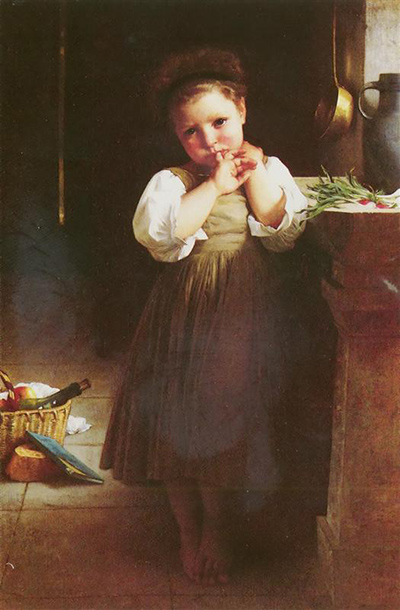Titled variously "Mauvise-Ecoliere" (Naughty Schoolgirl) and "Petite Boudeuse" (Little Sulky), this charming portrait was painted in 1871 by William-Adolphe Bouguereau, in his day one of France's the most revered artists.
Bouguereau's technical ability and academic brilliance led to his work being in demand beyond France and his classical images and female portraiture were valued highly by wealthy collectors in the United States, Holland and the United Kingdom, among others.
The young girl in this portrait is believed to be Jeanne, the younger of three sisters who lived close to Bouguereau in La Rochelle, south-west France, and posed regularly for the artist. Ironically, Jeanne was also the name of Bouguereau's third child, born on Christmas Day 1861 to Nelly Monchablon, a former teenage model from Lisle-en-Rigault with whom he lived unmarried from 1856 until they wed ten years later. Eight days after this, their daughter Jeanne passed away, aged just five, after suffering with tuberculosis.
In mourning, the couple decided to move to La Rochelle, where Bouguereau painted a portrait of his adored little Jeanne in 1868. It was around this time he met the little girl in this portrait, also called Jeanne. With her sisters Yvonne and Marguerite, they regularly sat as models for the painter's art. Nelly died in 1877, following the birth of a fifth child the previous year.
In 1896, after a 19-year engagement, Bouguereau married Elizabeth Jane Gardner, a former pupil, in Paris. During his lifetime Bouguereau (1825-1905) was feted as one of the greatest French artists of all time, with his work in great demand by collectors throughout France and the United States in particular.
In 1900, Edgar Degas and Claude Monet were quoted in an art journal as identifying Bouguereau as the artist most likely to be remembered one hundred years later but ironically, his technical brilliance was forgotten while their free Impressionist art was revered while his realism was scorned in later years and his work fell out of favour.
That technical expertise and academic depth eventually led to Bouguereau's rediscovery in the 1960s and 70s and his status, and consequently the value of his work, has been elevated once more to the higher levels he enjoyed during his lifetime.




